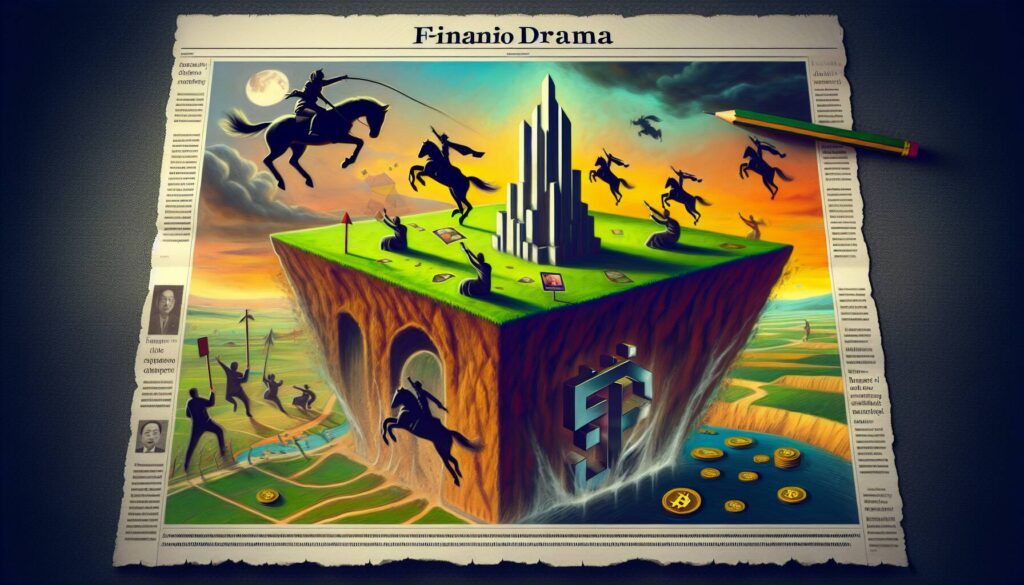The cryptocurrency market is experiencing a notable downturn, creating ripples through various digital currencies. Bitcoin (BTC) has dipped by 3% in the last 24 hours, settling under $115,000, marking it as one of the stronger performers among major cryptocurrencies. Meanwhile, the CoinDesk 20 (CD20) index has seen a steeper decline of 6%, with ether (ETH) down 5.7% after recently celebrating its strongest monthly growth in three years. XRP has fared even worse, losing over 7% of its value.
This decline in cryptocurrency values coincides with the latest tariffs imposed by the United States, which began to take effect and are expected to affect a range of key trading partners including Canada, the European Union, and Japan. The introduction of these tariffs, ranging from 10% to 41%, has impacted the equity markets across Asia, leading to their worst performance since April. Additionally, these trade policies have fueled a rally in the U.S. dollar, pushing its index above 100 for the first time in months.
The recent economic climate has also revealed a rise in the Federal Reserve’s preferred inflation measure, which now sits at an annual rate of 2.8%. The increase in inflation has tempered expectations of an interest rate cut in September, with market predictions shifting from a 56% chance of a reduction to just 38%. Such changes in monetary policy can significantly influence the crypto market, as lower interest rates generally bode well for riskier assets like cryptocurrencies.
“For crypto, looser financial conditions would be a major tailwind,” noted Matt Mena, a strategist at 21Shares, emphasizing the complex interplay between traditional markets and cryptocurrencies.
The forthcoming nonfarm payroll data is anticipated to significantly impact market sentiment, with predictions estimating 110,000 jobs added last month. As traders navigate these developments, many are employing protective strategies, particularly around Bitcoin, while also showing interest in the options market for Ethereum, suggesting a cautious outlook as sentiment shifts.

The Current State of the Crypto Market
Key points from the recent developments in the cryptocurrency market:
- Market Decline:
- Bitcoin (BTC) dropped 3% below $115,000.
- Ether (ETH) fell 5.7% while XRP lost over 7%.
- The CoinDesk 20 index decreased by 6%.
- Impact of Tariffs:
- U.S. tariffs, ranging from 10% to 41%, have started to affect trade with partners like Canada and the EU.
- Resulting economic conditions led to Asian equity markets suffering their worst week since April.
- The strong U.S. dollar index closed above 100 for the first time since May.
- Federal Reserve Concerns:
- Core PCE inflation rose to 2.8%, complicating potential interest rate cuts.
- Traders adjusted expectations from a 56% chance of a rate cut to merely 38%.
- Investor Sentiment Shifts:
- Increased bearish positioning for BTC among options traders.
- Balancing strategies observed for ETH options, indicating mixed sentiments.
- Economic Data Release Dates:
- Important nonfarm payroll data will significantly influence market expectations.
- Traders gauging job creation could pivot investment strategies accordingly.
- Crypto Innovations:
- Upcoming notable events include the Helium Network halving and the launch of fully bitcoin-backed stablecoins.
- Market movements also show a continued interest in NFT recovery and upcoming regulatory developments in various regions.
This information is vital for readers as it highlights the interconnectedness of global economic conditions, regulatory changes, and their implications for investment strategies in the cryptocurrency market.
Crypto Market Shift: Analyzing Trends and Implications
The recent downturn in the cryptocurrency market is no surprise, as Bitcoin and Ethereum face downward pressures amidst rising tariffs introduced by the U.S. This shift marks a significant moment for potential investors, steering them towards safer assets amid economic uncertainty. Competing narratives in the finance sector highlight the structural vulnerabilities of cryptocurrencies when juxtaposed with traditional markets and stablecoins.
Competitive Advantages: Some cryptocurrency assets, particularly Bitcoin (BTC), have historically offered some resilience during market dips. BTC’s relative stability in volatile times demonstrates its position as a cornerstone in portfolio diversification. Moreover, innovations such as Solv’s BTC+ vault, promising attractive yields, position Bitcoin as not just a store of value but also an income-generating asset through DeFi lending, providing competitive advantages over stagnant traditional financial products. Additionally, the ongoing adoption of NFTs, particularly the surge of CryptoPunks, indicates consumer interest and engagement remains strong in specific sectors, which may excite new investors.
Disadvantages: However, the current landscape points to growing challenges for cryptocurrencies. The impact of tariffs has provoked fear and uncertainty, leading to increased bearish positioning among options traders. Reports suggest hesitance toward further investments in Ethereum (ETH) as the options market indicates higher risk, a reversal from prior bullish sentiment. Moreover, the campaign against crypto regulations poses additional risks, potentially stifling innovation and adoption at a critical juncture.
For investors keen on yield-bearing opportunities, the rise in interest rates could pivot their focus towards stablecoins as a safe haven in this tumultuous environment. On the other hand, retail investors drawn to the speculative nature of Bitcoin and Ethereum could find themselves facing challenges, pushing them to seek out alternative investments as volatility looms. Thus, a bifurcation of strategies may emerge, where traditional investors leverage stable assets against the backdrop of an increasingly regulated cryptocurrency space.
As the market currently stands, observers must remain vigilant. The confluence of global economic policies and evolving crypto dynamics will play a critical role in shaping the future trajectory of not only Bitcoin and Ethereum but also the broader digital asset landscape.
















